History
For this section, I used several references including the Sam Nieswizski book, named "Rollermania" (Découvertes Gallimard) and the Jean-Christophe Berlot one, "Les riches heures du patinage" (Mango Sport).
Ice skates, made with equidae jawbones, were found in Europe, from the paleolithic age. Even then, prehistoric man was already a skater.
For centuries, skates were only tools for moving on frozen areas. Progressively, they were used as equipment for recreational activities. But in a lot of countries, skating is only possible during winter.
In the 18th century, some skaters had the idea of fixing wheels on their blades. The wheel number varied between two and six per skate and they were inline. The first official inventor was John Joseph Merlin with his metallic wheels towards 1760. His skates were not used because falls were numerous and painful. Van Lede, a Dutchman living in France made in 1789 skates named "patins à terre", allowing the users to skate out of doors.
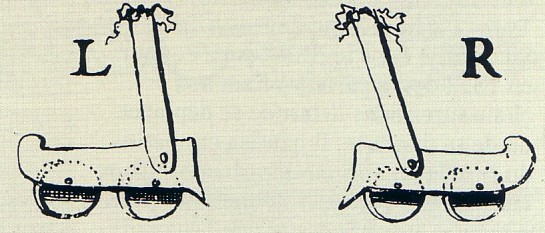
The Van Lede skates
In 1819, the Frenchman Petibled was the first to take out a patent. His skates could be in wood, in metal or in ivory. A screw placed under the heel was used as a brake. They were fixed on boots or provided with straps. Trials were encouraging but weight, imprecision and instability of the ground were obstacles to success. There was a succession of inventors : Spence, Tyers (1828) and wheels with different diameters for a better manoeuvrabiliy, Löhner (1825) with his skates "volito" (the first with two rows of wheels). Jean Garcin, a famous ice skater invented in 1828 the "cingar" skate, which had a great success and was made until 1839, because of an efficient advertising. Louis Legrand had success too in 1849, when Meyerbeer created his opera named "Le prophète" and asked him to make skates for the show, to maintain them and to train the dancers. This show was one of the first to use skating and was played in Europe and the United States. Legrand skates, less elaborate than the Garcin or Tyers ones, were used until 1876, because of the show. Skating schools appeared, most of the time in gymnasiums.
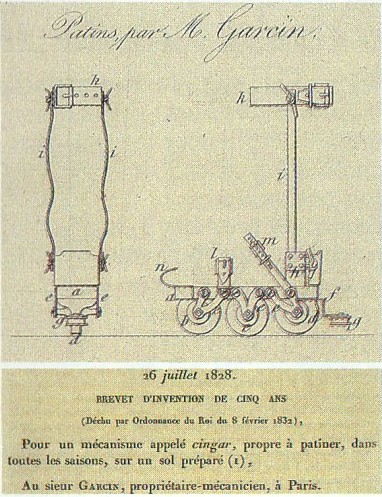
The Garcin skates
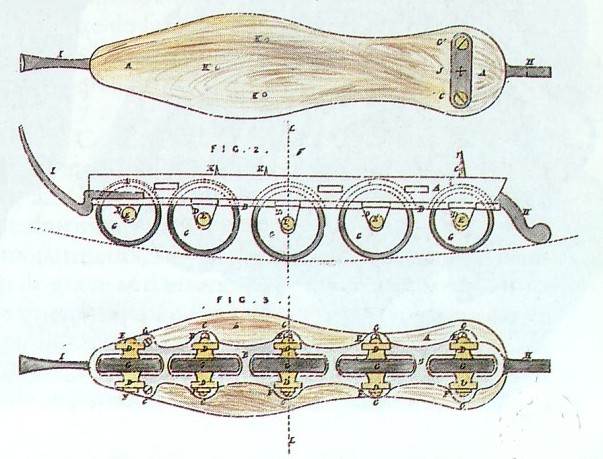
The Tyers skates
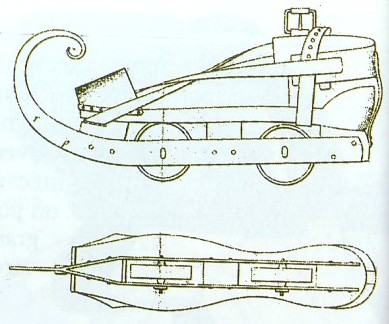
The Legrand skates
The year 1863 was a revolution with the James Leonard Plimpton skates. Wheels stopped being inline and became adjustable using movable axles. Then, figures were possible. These skates, called "rocking skate" were equipped with a lubrification system, grease being stocked in a little reservoir.
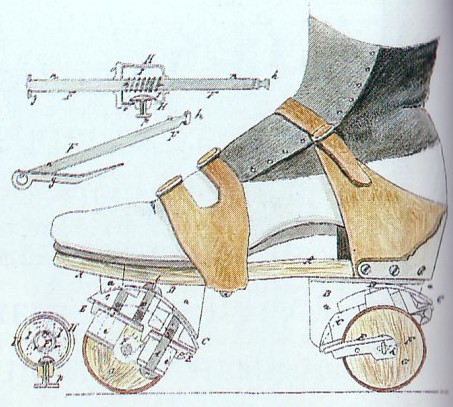
The Plimpton skates
Next year, the Englishman Johannes Badrutt, who had bought an hotel at Saint-Moritz (Switzerland) proposed to his rich guests, who had come for a cure during summer, to come back with no charge during winter because they couldn't believe it is milder than the English winter. They should come and enjoy. During the next winter, the hotel was full of English tourists relaxing, tobogganing, skiing or skating on the frozen lake : it was to be the beginning of winter sports.
The Plimpton skates were not sold for personnal use but rented in special places : the "skating-rinks". However, as these skates were heavy and dirty (because of grease), old skates were still used.
Just as there were places to ice skate ("le palais de glace" in France), numerous skating-rinks (for roller skates) were built in the United states and in Europe. Tracks of more than 2000 square meters, very luxurious, were in general reserved for the upper class. However, roller skating went out of fashion, and in 1880, only one rink existed in Paris, compared with about fifteen some years earlier, but "le palais de glace" will be still open in the 20th century. The cooling pipes system allowing ice to be made in an ice rink was invented in 1865 but was really only used many years later because making ice is very expensive.
In these rinks, the first figures were created. The Americans Fuller and Haines, excellent skaters on ice as well as on rollers, made shows creating original figures such as spins. Iw was at this time that the first competitions appeared. In 1868, Jackson Haines wanted to dance to music in Vienna, where he had a great success. During the first international competitions of ice figure skating, in 1882, there was a figure event and a dance event, created by Haines, corresponding to the long programme. This sport is also an art. On Haines' tomb is writen "The king of skaters".
Concerning roller skating, the other revolution was to be the use of ball bearings, at the end of 19th century, by Levant Marvin Richardson. The cylindrical rubber bearings, driving the axles to their balanced position, were the second innovation he brought with regard to the Plimpton skates. Only plastic wheels would bring a real innovation in the future. Richardson skates and their imitations will be very much used. At the end of 19th century, there was also the period of the "cycles-patins" (inline skates), many years before actual rollerblades, in use since 1990.
In 1893, ISU (International Skating Union) decided to organize international championships, but the rules were not defined with precision. At that time the ranking was polemic and championships were cancelled. The notation systems were then created. Jumps realized by actual skaters are from this epoque. Axel is from the Norwegian Axel Paulsen towards 1880. The Swede Ulrich Salchow invented the jump with the same name in 1910, while the German Werner Rittberger created the loop jump. The Austrian Aloïs Lutz was the inventor of the jump with the same name, but we do not know a lot of things about him. We can note that in 1902, an English woman, Madge Syers, registered at championships, and skated because there was nothing in the rules forbidding women taking part. She finished second but championships were to be only for men the next year, on the pretext that dresses were long and hid the movements of the feet. Women had to wait until 1906 to obtain their championships.
All these champions could also skate in Saint-Moritz. Hans, grandson of Johannes Badrutt, invited them to give shows to the customers of the "Palace", his father Caspar's hotel. Pierre and Andrée Brunet, Sonia Henie and Gillis Grafstrôm were then able to train without much expense, in the place where the Olympic Games in 1928 and in 1948 were organized. Ice figure skating has been an Olympic sport since the first winter Olympic Games in Chamonix in 1924. Outside championships were abandoned in 1967 because of the incertainty of the weather, that could force the events to be postponed, and the ice was not perfectly flat. However, landscape was magic for skaters. Another place for training is "le palai de glace", where Frenchman Pierre Brunet created his skating programmes at the beginning of the 20th century. There were no lessons, however and students had to learn the figures from books. Moreover, the rink was also open to the public so there was not a lot of space.
After a period of neglect, roller skating came back in 1910. People were greatly interest in sport and especially in skating. Several establishments opened (a dozen in Paris) and competitions were more and more frequent. From the United States, roler polo became rink-hockey, inspired by ice hockey but different. Dance contests were organized. Wheels were in metal (steel, cast-iron, aluminium) ; in wood (ash, boxwood) ; in fiber (mica), or sometimes in buffalo hide. Since 1884, speed or endurance records had been established. The French federation of roller skating was created in 1910 and organized the first national championships with three activities : figure skating, speed skating and rink-hockey. In figure skating, there was the school figure event (very complex shapes such as the rose) and the free figure event. In speed skating, there was the 1 km event and the 30 km event. One race well known between 1910 and 1914 was the "patin d'or" one, taking place for 24 continuous hours, where some skaters covered a distance of more than 450 km. Other people, thinking than roller skating was too tiring, invented motorized skates, as did Constantini in 1906.
After the First World War, roller skating was abandoned by adults and became a game for children, with simple and cheap skates with straps. Adults on roller skates still competed, though, in championships. Their skates were gradually improved technically. International championships appeared : the European ones of rink-hockey in 1926 and the Worlds ones in 1936 ; the European figure ones and the World speed ones in 1937 ; the World figure ones in 1947. In 1935, in Chicago, the roller derby was created called "roller catch" in France, where it appeared in 1939. On a cycle-racing track, two mixed teams confronted each other in a race where striking was allowed. At the same époque, the "Skating Vanities" company was on tour around the World with great success. The show was similar to "Holiday On Ice". For several years, roller shows were seen in circuses.
The German ice figure skater Charlotte succeeded in running her show for 300 days in Broadway in 1915. She is recognized as the first woman to land an axel jump and as the creator of the "death spiral". Shows on ice were to become more and more numerous in the United States, allowing to champions to live by their sport.
In 1931, the Swede Gillis Grafstrôm did a show with figures drawn on the ice with his blades. School figures, inspired by Grafsrôm's work, had a very important place for the rankings in championships but were not very popular, spectators preferring free skating. As rankings were polemic because they were partial to school figure skaters, school figures had a lesser importance from 1970 (teh short programme appeared), and they disappeared completely in 1990.
Ice dance was an event of the World championships in 1952, and of the Olympic Games in 1976. This sport is sometimes confused with pair skating, an event of championships since 1908. Pair skating uses the same figures as individual skating, with throw jumps, pair spins and lifts in addition. Dance skating doesn't have acrobatic figures, it consists of finding steps and positions to produce an aesthetic choregraphic effect.
The Second World War put a stop to roller skating again. In 1979, plastic wheels were to give it wings. In 1980, roller disco, excursions and acrobatic street rollers (at the Trocadéro in Paris) were more and more practised. The years 1990 brought a new change with rollerblades. Speed skaters would use this type of skates, allowing better performance. A majority of excursion skaters use them too. Roller hockey was created, corresponding to ice hockey, contrary to rink-hockey. Only roller figure skating uses more quads than inline skates. However, inline figure skates exist and are improved at regular intervals by ice skaters or roller figure skating ex-champions.
Over the past few years, two other events appeared on ice and roller skating : precision skating and ballet.
Some first jumps in roller figure skating :
1940 : first jump in championships (lutz by B. Towle)
1940 : first double jump (double salchow by S. Baxter)
1959 : first triple jump (triple loop by Genearless)
2002 : first triple axel by Luca d'Alisera
Some first jumps in ice figure skating :
- Men :
Dick Button (USA) : double axel, triple loop (first triple jump) (1952)
Don Jackson (Canada) : triple lutz (1961)
Vern Taylor (Canada) : triple axel (1978)
Kurt Browning (Canada) : quadruple toe loop (1988)
- Women :
Jacqueline Du Bief (France) : double lutz (1949)
Denise Biellmann (Switzerland) : triple lutz (1978)
Midori Ito (Japan) : triple axel (1989)
The differences between ice and roller skating :
As we have seen, roller skating tried to copy what existed on ice, but with difficulties. An evolution of materials and techniques was necessary to reach satisfactory results. In consequence, roller skaters were less numerous than ice skaters, and had to make more effort. As an illustration, you can read these following judgments about roller skating made by ice skaters during the 19th century : "Results are too restricted to be able to give the description of this type of eccentric skating. [...] It is not possible to compare wooden floors or asphalt with the great and shining area of beautiful ice, that can, alone, by its large area, allow the most audacious movements" ; "A stone, a gravel, a cigar piece, a straw unexpectedly met are enough to make the most experimented skater fall over" ; "Tiredness caused by these roller skates is quadruple that caused ice skates". We must agree with the author of this last opinion, because roller skating is more physically exhausting. However, weight and material quality are constantly improving and the difference in the technical level is constantly reduced.
At this time, roller skating provides more activities than ice skating. As a matter of fact, acrobatic roller on slopes and springboards or excursions do not exist on ice, and all the activities on ice have one or several adaptations on roller skating. However, these last activities, they are generally better known on ice. Ice skaters often ignore the fact that their sport exists on roller skates (speed skating, figure skating, ...). Ice championships are often retransmitted on TV because it is still an extraordinary underworld, not much visited by spectators. Roller skating is more popular in hot countries, where ice is rare or inexistent.
I shall end by giving a comparison between roller figure skating and ice figure skating. Even if roller skating needs more effort because of the weight of the skates, difficulties presented by the best world figure skaters are very close to the ones in ice skating. Some male roller skaters can land a triple axel (three and a half revolution turns) and have begun to train in quadruples jumps that male ice skaters perform in championships. Figures are often the same, but the technique to do them is not. Roller spins can be more varied, because they can be "classic" (on the four wheels), on heel (on the two back wheels) or on "broken ankle" (on the two edge wheels). On ice, a spin is possible by leaning the body weight lightly forward onto the front of the blade without reaching the toe pick. A reverted spin is impossible on ice. We can note that the American Michael Weiss now uses new blades allowing him to skate on heel, so the possibilities could be greater if these blades were to be used by more and more skaters. Apart from effort, the difficulty of both types of skating is the same. It is incorrect to believe that a thin blade is less stable than two rows of wheels, because blades grip the ice surface and wheels don't (they are hard and polished on a hard and polished floor). Moreover, wheels are not completely fixed to allow edges. For my part, I may reproach roller skating for not showing all the possibilities of figures during championships. For instance, we only see camel or reversed spins because they are more valuable. But international rules are responsible for this ...
Concerning inline figure skating, it is such as a mix between roller and ice skating. Some skaters are able to land a triple toe loop or a triple salchow, and it is possible to make all the ice spins and heel spins. To me, inline figure skates allow faster moves but we need time to control edges. Future will say to us if it is possible to obtain the technical level of roller skating with this type of skates.








